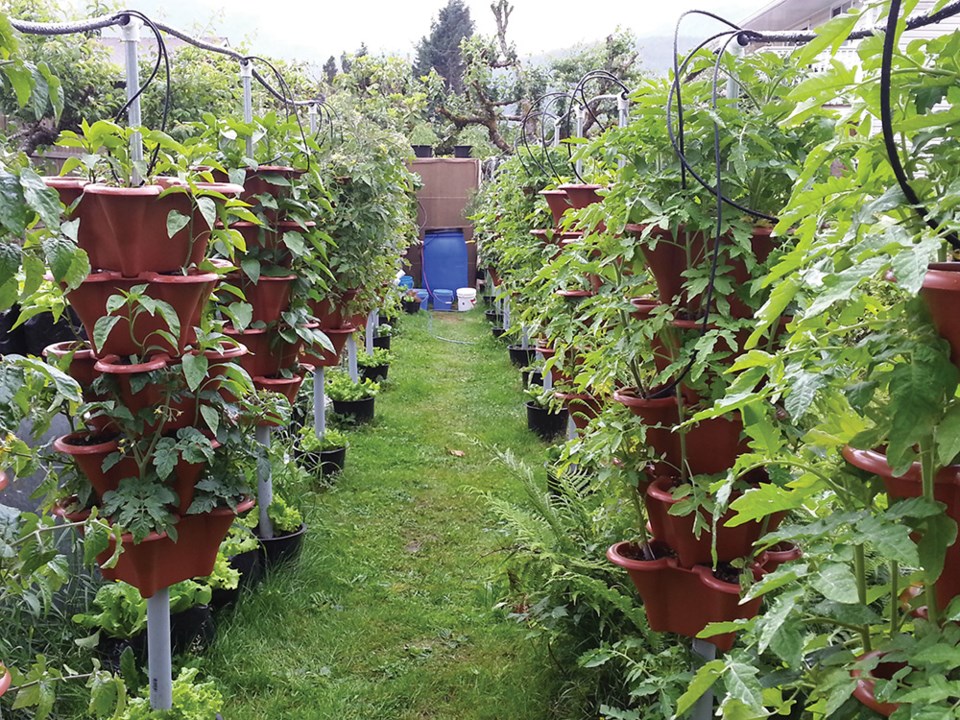When it comes to vertical gardening, it’s not how much space you have, it’s what you do with it that counts.
Vertical gardening (think “living walls,” tomato cages or climbing pea tendrils) is one of the hot new gardening trends, and is a great way to disguise a bare wall, a boring fence or to add beauty, colour and vibrancy to your space.
“It’s about maximising your growing space through height as opposed to a typical garden, which is usually done on the flat,” explained Kent Elchuk, keen vertical grower and founder of Squamish-based Growlode.
Whether you live in an apartment, a townhouse or a large family home, vertical gardening will help you make the most of every square inch available.
It’s also a method that’s known for greatly increasing yield, explained Elchuk, in addition to minimizing disease and pests by keeping plants above ground.
Elchuk’s garden, for example, is 300 square feet, in which he houses 100 vertically arranged pots, producing more than enough fresh vegetables for his family (and very often friends too).
A family of four could probably produce all they need from 50 pots, he explained.
“Vegetables that do well with vertical gardening include lettuce, cucumbers, jalapenos, tomatoes, bell peppers, herbs and peas, among many others,” he said.
Typical vertical growing structures include garden trellises, wire cages, frames or even twiggy branches in the case of peas.
Elchuk, however, has gone one step further and uses a system of vertically stacked pots, supported by a rigid frame fixed into the soil.
The entire structure is also hydroponic, meaning that it’s soil-less. Instead, the roots grow in a liquid nutrient solution and hydroponic growing media, such as peat moss, perlite, and kiln-dried sawdust (all of which are both affordable and available locally).
“After many years of organic and hydroponic research, I felt there had to be a way to produce all kinds of homegrown, pesticide-free food in a beautiful, low maintenance system that would pay for itself almost instantly, he said. “Hydroponics and organic hydroponics just make sense as it enables the grower to conserve water and fertilizer while growing high yields in shorter periods of time.”
It also requires very little maintenance. For example, Elchuk waters and fertilizes his 100 pots using fewer than 50 gallons of water (about one and a half showers), delivered through tubing by a pump.
The cost of which is about $1 a day, he explained.
“In the water shortage world, it’s a very timely way of doing things, especially in Squamish where there are water restrictions,” he said.
As an experienced web developer, he has also developed technology which help monitor his garden remotely (and those of others whose vertical gardens he sets up), to make sure no feedings are missed.
Through this reliable nutrient-delivery system, Elchuk is able to grow stronger, healthier plants which, in turn, ward of pests and diseases with greater ease and produce higher yields.
Everything tastes more delicious too. “We rarely see tomatoes in the store that are ripe – they’re picked so early that they rarely have any flavour.
When they’re ripe and juicy and big they taste like the real thing. There’s no comparison.”
Being in the garden, standing among his towering vegetables, is a really great place to be, he said.
“I really love standing in the middle of it and seeing where everything is growing... Above your head are four feet of plants; look down four feet and there are more plants. It’s a garden lover’s paradise.”
So, whether you’re a minimalist gardener who likes a less-cluttered look or a keen gardener looking to increase yields, vertical gardening can be a great system for any space.
For details about Growlode visit www.growlode.com.




